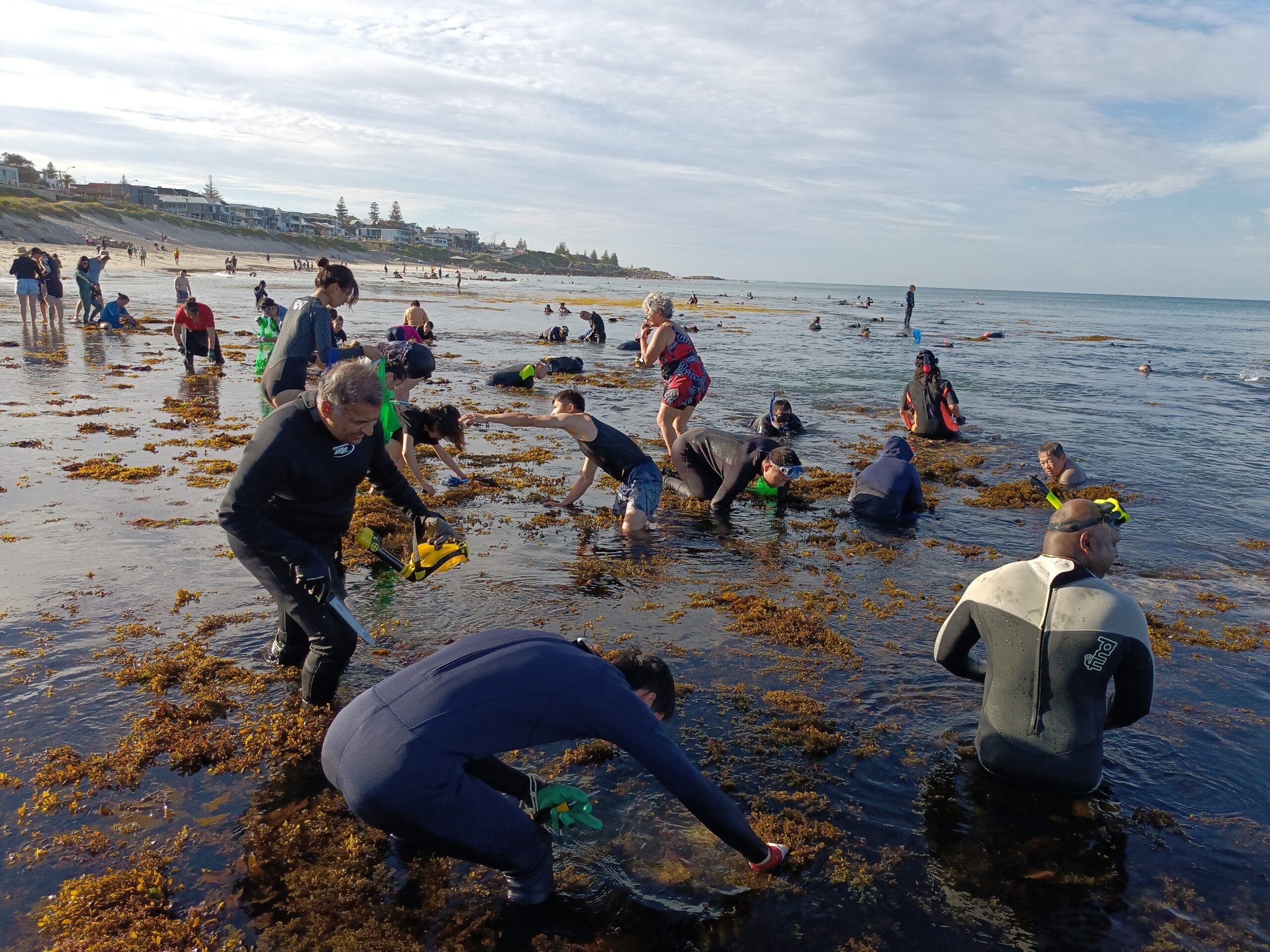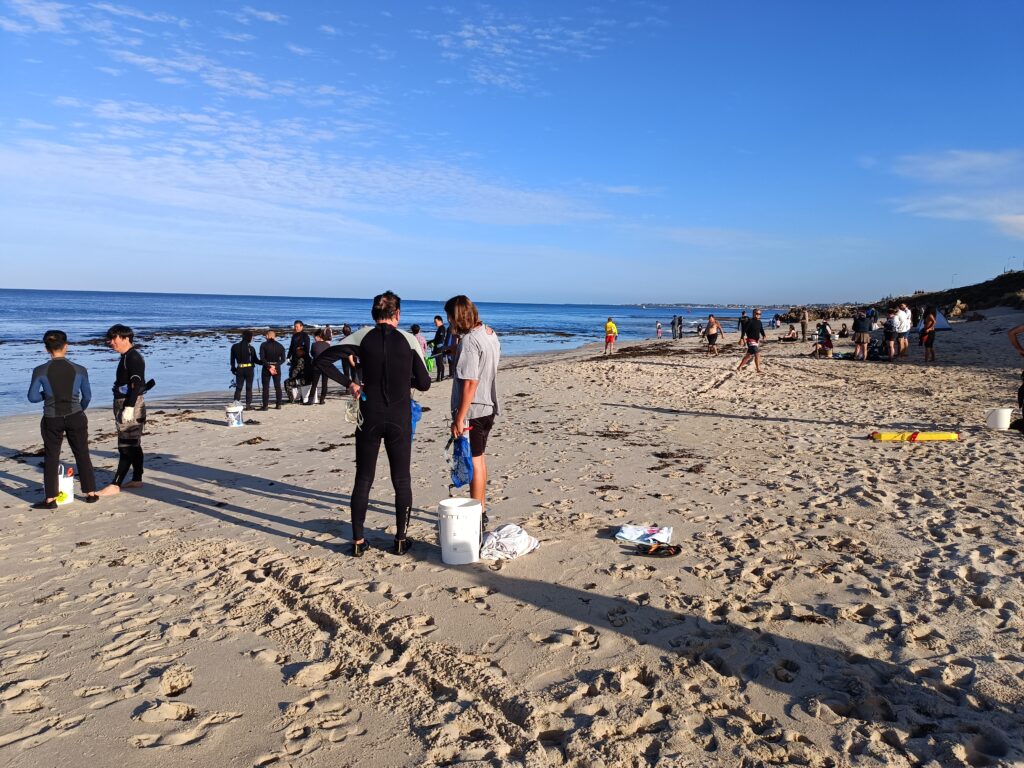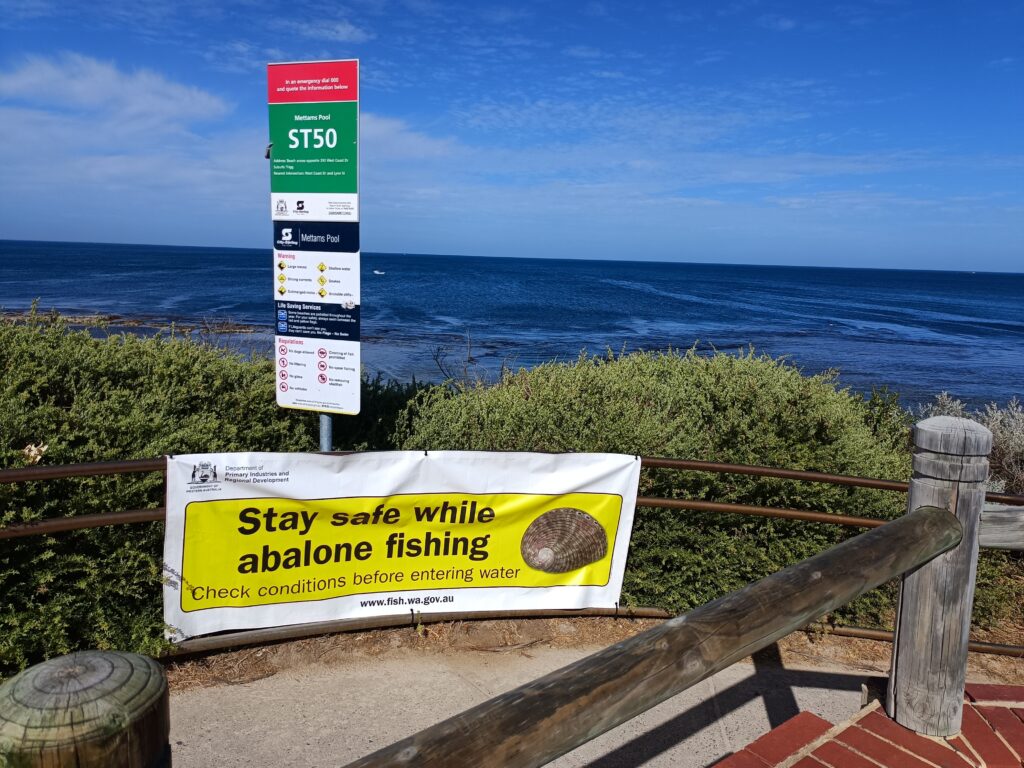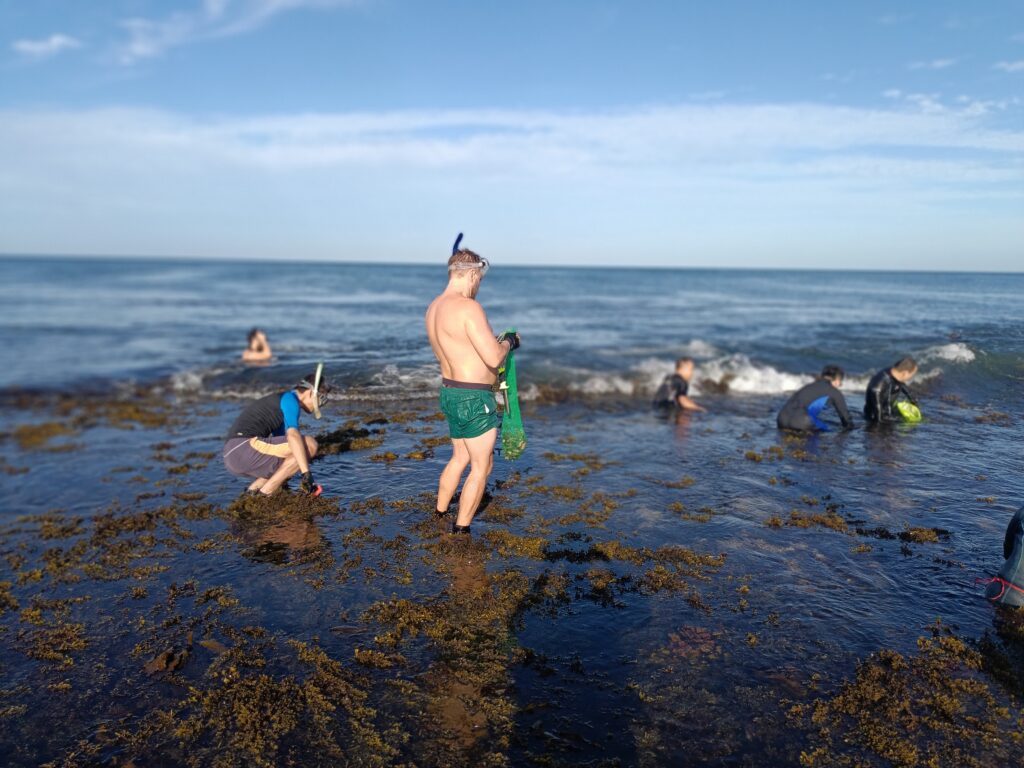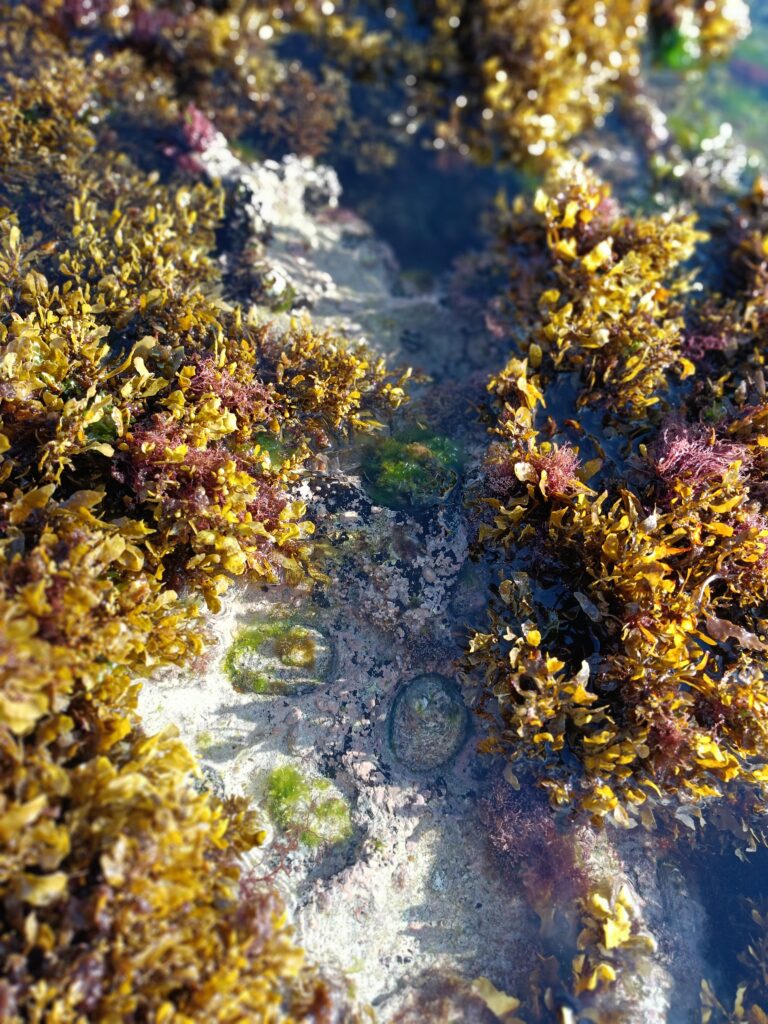I’m walking down to Mettam’s Pool, wearing my press pass on a lanyard, neoprene booties and the bottom half of a wetsuit. Looking down from the footpath, the ocean looks like glass, the tide so low that spires of the limestone reef protrude through the surface.
At 6am on a Saturday, the beach is already bustling. Groups of people cluster around white plastic buckets and empty eskies, casting long shadows towards me as they look out over the water.
Mettam’s pool is a natural basin, a large bite taken out of the limestone that meets the beach along much of Western Australia’s coast. On this intertidal shelf, covered in plant life and pitted with holes formed by the eddies of ancient tides, live thousands of Roe’s abalone.
Abalone are abundant in the temperate waters along the southern coast of Australia. They’re a delicacy – the shellfish equivalent in prestige to oysters and scallops. However, abalone are genetically distant from those bivalves – they’re sea snails with nacreous shells, comprising the only genus in the family Haliotidae. To eat abalone is to eat the fleshy foot the snail uses to move and to hold on to the reef.
PLAY BY THE RULES
In Western Australia, abalone fishing is tightly controlled by the Aquatic Resource Management branch of the Department of Primary Industries and Regional Development (DPIRD). Controls ensure that the number of abalone taken stays below a target called the “total allowable recreational catch,” determined by DPIRD each year.
To this end, recreational fishers must purchase an annual licence to access the fishery, and their catch is constrained by bag and size limits.
This year, Roe’s abalone can only be kept if they are wider than 60mm. In the West Coast Zone, spanning from Moore River to Busselton, each fisher is only allowed a maximum of 15 abalone per session – a number that has been slowly reducing in response to declining stocks.
In addition to these rules, fishing in the West Coast Zone is restricted by “spatial and temporal closures”, or set windows of time in which to fish, announced each year. Abalone fishing is only permitted for 4 hours this season – from 7am to 8am on each of four Saturdays across the summer.
Fishing is often imagined as a solitary, reflective pursuit: one person waiting as the currents and the hours flow past. Abalone season is a bottlenecking of these expanses of time and space, putting fishers shoulder to shoulder against the clock and under the scrutiny of DPIRD officers, who patrol the beach, ensuring the rules have been followed, and weighing and counting the catch.
I wander down the beach gathering recipes for abalone from the waiting crowd. There’s a wide range of preferences, from raw, to battered and fried, to east Asian and southeast Asian preparations that reflect the fishers’ cultural heritages.
No matter their cooking preferences, there’s two things everyone can agree on. One, the molluscs have to be tenderised, and two, Roe’s abalone are loved by everyone here. Many conversations, leave me uncertain if this love is for the taste of steamed abalone congee or for the excitement of the upcoming hour.
As the clock strikes 7, the crowd flows into the water and settles in across the rocks, ready to take their share of the Perth metropolitan abalone fishery off the reef.
A FINE BALANCING ACT
Prior to attending the abalone fishing session, I spoke to Druimé Nolan, a Fisheries Management Officer at DPIRD, to hear more about how the department manages the sustainability of the fishery.
She described how continual monitoring of the abalone population, the marine environment and fishing activity informs the harvest strategy documents, which are developed every 5 years to guide the government’s approach to conserving the wild-caught resource.
“The whole entire resource will be assessed per year, and we’ll also have a mid-year review, where we’ll [decide] what the catch will be for Roe’s,” says Druimé.
For the past few years, that number has hovered just above 20 tonnes of Roe’s abalone for recreational fishers. The 5.3 tonnes taken off the reef during the first hour of the season is in line with meeting this target.
From an outside perspective, it seems like DPIRD has an unenviable job. It’s the only thing standing between the ongoing survival of the abalone population and the desire of recreational and commercial fishers to eat them into extinction.
I cautiously pose this narrative tension to Druimé, and she states: “We will consult with all these groups and get advice from our scientists and put it all together and find a middle ground.”
However, there’s something about this picture that doesn’t make sense to me. Why does a population of animals have to be protected from people who pronounce their love for them? And what does the future hold for Roe’s abalone when the rules for their harvest are decided in consultation with people who want to eat them?
A DANGEROUS HOUR
It’s 7.15am, and people wearing everything from spearfishing wetsuits to jeans are paddling in potholes and crouching over the reef. When looking for abalone in the water, the eye first catches on a line of small circular holes near the outside of the shell, before tracing a golden-ratio spiral inwards.
The recommendation is to first measure the abalone with a metal gauge, then use a flat edged tool to gently dislodge them. I see people wielding knives, screwdrivers, and even barbecue tongs, tossing their catch into mesh and fabric bags.
Today’s conditions are calm and flat, with infrequent waves brushing past our ankles. This isn’t always the case. Reefs can be dangerous, especially for those who are not strong swimmers.
Nobody understands this better than the Surf Life Saving WA coordinators and volunteers, who help determine which days will be safe to fish, and turn out a sizeable presence to keep people safe.
On the first hour of the 2023/24 abalone season, Lifesaving Department Manager Cam Robbins says that lifesavers completed 570 preventive actions, 10 first aids and 19 rescues across the Perth metro sites. Around 160 volunteers work each session, with their beach patrol backed up by jet skis, boats and a rescue helicopter.
Cam claims that abalone fishing is the “most dangerous recreational fishery in the world”. Since 2012, six people have drowned.
“We just want to ensure people come home to their loved ones after doing abalone fishing,” says Cam.
MORE THAN JUST CATCHING ABALONE
The lifesavers on the beach are relaxed. Their emergency flotation devices rest on the sand as they look out over the perfect conditions.
Still, I’m mindful of my footing as I chat to a young man, tanned with sun-bleached hair. He’s wearing a camouflage patterned wetsuit and endearingly pronounces abalone so that it rhymes with “bone”.
He describes fishing in deeper water with something close to reverence.
“You’ll be swimming out the back of the reef, where there’s all those swim throughs and that. You look above your head, and the entire surface of a rock will be painted with abalone. It’s beautiful.”
A pair of older men describe years of fishing together, their complaints belying a deep, hands-on understanding of the changing marine environment. Their comments precisely mirror Druimé’s description of the fishery trends.
“We used to be out about seven times a year,” one says.
“Yeah, it’s declined big time. The bag limit used to be 20,” the other chimes in.
The first adds, “We used to be in and out in like 10 minutes, and now you’ve gotta look for them.”
As a keen diver who chooses not to fish, the moral high ground I’ve been standing on is starting to feel shaky.
To be so entangled with the history of the abalone fishery is surely to be tied to its future. If something were to happen to the abalone, like a repeat of 2011’s deadly marine heatwave or a different unforeseen climate disaster, these fishers would be the first to know and the most likely to care.
FISHING FOREVER
To understand the link between fishing and fishery management policy, I speak to Sam Russell from Recfishwest. As the peak body for recreational fishers in WA, Recfishwest represents their interests to DPIRD in the development of the harvest strategies.
Sam tells me that 12 hectares of reef supporting a million abalone was destroyed to make way for a new marina development at ocean reef. More than a million abalone were lost from the stock, contributing to the decreasing number of fishing days in the season. For Sam, concerns for both the abalone and their fishers are rolled into one.
“We had a loss of habitat, and a loss of access for abalone for recreational fishers, which was quite disappointing,” he says.
“Our biggest thing is maintaining good fishing experiences forever. That’s the idea behind what we do, and sustainability and conservation definitely comes into that.”
“Rec fishers care about the fish potentially more than anyone else.”
Back at Mettam’s Pool, someone slips me an abalone as they head out of the water with a bulging catch bag, eyeing off the DPIRD officers patrolling the sand.
The shellfish is heavier than I expected but barely larger than the minimum size.
I walk back out into the water, watching as green tendrils slowly emerge from under the shell. The abalone suctions firmly onto my hand, shifting to nestle into the curve of my palm. I unstick it, and plunge it into a deep hole in the limestone, hoping it’ll survive – at least until next season.


